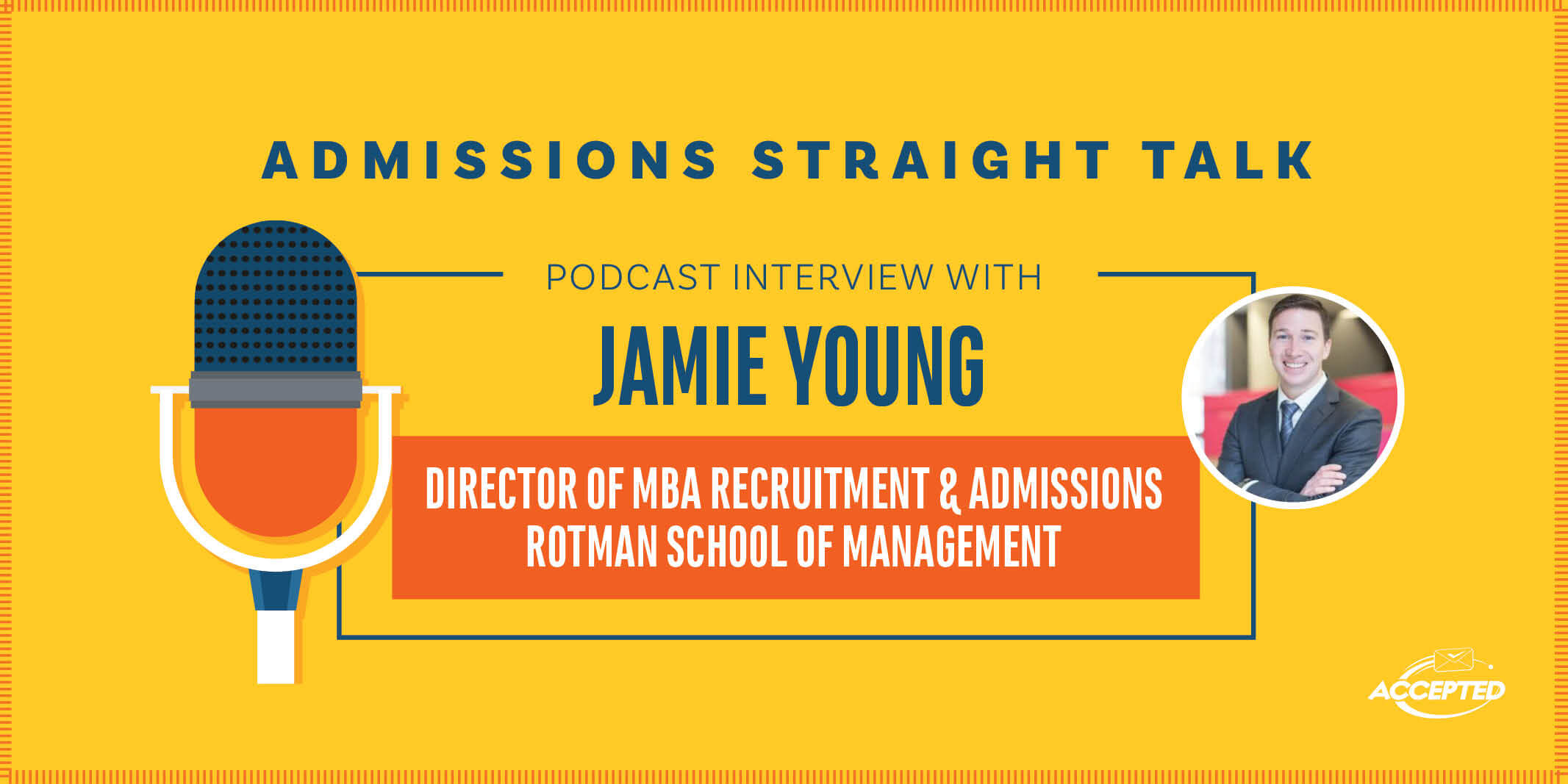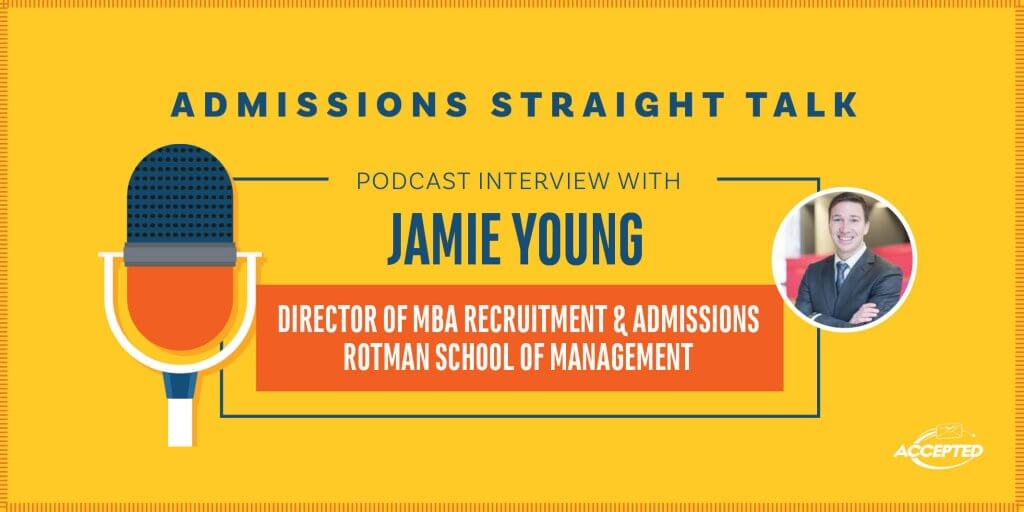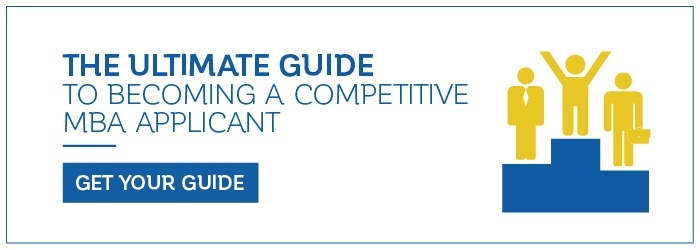
Today for the first time we welcome Jamie Young, Director of Recruitment & Admissions for the Full-Time MBA Program at the Rotman School of Management at the University of Toronto. Jamie graduated from McMaster University in 2008 and has worked in Canadian higher ed since then. He came to Rotman in January 2016 to assume the role of Director of Recruitment & Admissions. He also serves on the ETS Business School Advisory Council and Forte Foundation’s School Advisory Council.
Can you give an overview of the Toronto Rotman FT MBA program with a focus on its more distinctive elements? [1:44]
Our program combines 16 months of academic study with a 4-month internship opportunity. We offer 15 diverse majors, so candidates can choose to specialize in their second year, and there is something for everyone. You can choose everything from health sector management to brand management to investment banking to real estate management. It’s really up to you. So while we are renowned for our strengths in strategy and finance, we have a number of strengths.
Some of the things that are more distinctive are the Creative Destruction Lab, a course in the second year of our program that infuses a lot of things from across the university. It is a seed-stage program for massively scalable science-based companies, and at Rotman we have the largest concentration of AI companies of any program here on earth. Our Self Development Lab runs alongside curricula, with workshops designed to help students express themselves more effectively, understand their own motivations and of those around them, and work toward achieving their goals in complex and high stakes environments.
What’s new at Rotman? [3:56]
We are really proud of the flexible internship program, an innovation we announced just over a year ago. Students coming into the MBA program have the opportunity to complete their internship in one of three periods, our traditional which is the summer, but also the winter or fall. Right away there is this increased opportunity for flexibility, with students able to tailor their experience towards exactly what they are looking for. It also adds a lot of opportunities for students – there are organizations and companies that can offer really rich projects. We have seen incredible growth in postings, and it is an innovation we are really proud of.
We have also added an applied management placement course. We have some faculty and executives in residence guiding students through their internship experience, which is incredible to watch. So we see somebody with great experience of their own, and mentoring students to really reflect on their own larger goals. The execs connect formally with students and do exercises with them. One example is for the student to find individuals within the internship organizations who have experienced success, and then working back to figure out what the elements of that culture are that could help set the students up to be successful. It’s all about connecting and applying, making sure you are working toward achieving your larger goals.
Sometimes students want to complete more than one internship but that’s not a possibility. I will say that with the Creative Destruction Lab there are sometimes more opportunities, as sometimes students take on a CFO or COO role for some of these seed-stage startups, and it becomes more of an applied-learning internship.
At the AIGAC conference you were the only happy face on a panel discussing the changing views on immigration in the U.S. and the U.K. and their impact on MBA application volume. Why were you smiling? [10:03]
It was a nervous smile in the sense that I know it’s been a difficult time for my peers being on the other side of this. It is a difficult situation for a lot of people, yet we’ve been through a cycle and seen the increase in our applications. There has been a spotlight shown on Canada, and people like what they see.
We have an inclusive society, and Toronto is the most multi-cultural city in the world. There’s a wonderful opportunity for Canada and the city of Toronto and our full-time MBA program. We doubled apps from 2012-2017, and have seen a 40% increase in applications just for round 1 this year again. This is a continued trend, so we don’t attribute it necessarily to what’s going on geopolitically, but the way I’ve reconciled it with myself and my team is that people are more open to opportunities and casting a wider net.
One of Rotman’s unique calling cards is its focus on business design with the “3 Gears of Business Design – empathy and need finding, prototyping and experimentation, and business strategy.” How does that infuse the experience at Rotman? [14:21]
Our teaching pedagogy anchored around model-based problem solving and business design is a creative problem solving methodology with students solving for something that is new. It delivers on the promise of a new way to think, which is what Rotman students are known for. Using Creative Destruction Lab as an example, it is unlike most MBA courses in that there will not be as much clarity at the beginning of the course. There are these massively scalable science- and tech-based, AI, machine learning, and quantum machine learning companies, and our students are driving the equity value at that seed stage. It is pretty unclear about how to move forward, so it’s about looking at these disruptive technologies and trying to solve for a new way. Our students working in the CDL are creating a new business that isn’t following a path already created. The destruction piece is all about destructing prototypes, questioning norms, failing forward, and going back to strategy as you do that. Essentially strategy as the “true north.”
Let’s turn to the application. Your site says that you are looking for 4 qualities:
1. Intellectual Horsepower
2. Experience and Impact
3. Communication and Presence
4. Spike Factor.
Can you unwrap each of them? I’m especially interested in the “Spike Factor”? [18:02]
For intellectual horsepower, our faculty are third in the world for research, so the people who fit in that type of environment are intellectually curious and nimble, so we look for that with GPA, GMAT/GRE (which is waived for a CFA level 3 charterholder), or additional coursework being done, like professional certifications or MOOCs.
For experience and impact, we are a post-experience program, and recommend at least two years of experience, though that is not a hard rule, there are always exceptions. Our average is about four years but regardless of experience the focus is on impact. So in looking at the CV, we are trying to understand much more than what you are/were doing, but impact and influence to this point, which translates to possibilities for impact in the future as an alum.
With communication and presence, we were the first business school to introduce video interviews, and I am so grateful it is part of the process. I can’t imagine through this growth in applications how we would be able to get to know applicants well without those videos. It is great to see other schools moving that way as well. It provides a three dimensional view of each candidate – the first thing we do is look at a candidate’s resume alongside the videos. The self-reflection questions and a timed response in addition to a traditional essay give us a cohesive understanding of communication style and ability from a candidate before we would even invite them for the interview.
The “spike factor” for us is about how passion, perseverance, resilience, and determination show up in your life, and how you build that narrative throughout your MBA application. So we’ve had Olympians, professional athletes, professional poker players, or individuals who have traveled to more than 40 countries or speak 10 languages by the time they are 25 – the spike factor for those types of applicants is probably easy to understand just from mentioning those backgrounds. As we look for the spike factor, we want to see applicants knowing themselves, knowing what their own spike factor is, and knowing how to articulate it – reflecting on and understanding who I am and what I’m looking to do and how the MBA fits into that larger picture. Spike factors are often buried, and no two spike factors are the same. We pulled this idea from best practices in corporate recruiting, and it becomes that ultimate differentiator.
What distinguishes applicants who get interview invitations from those who don’t other than stats? The spike factor? [29:30]
Absolutely. That’s one element. Given the application volume we still pride ourselves on getting to know our applicants really well. Since we have a high touch admissions process, we want to develop as rich a picture of candidates as possible before we make a decision. We inherently believe that having more information is going to help us make our best decisions. How do you do that when applications continues to grow at an accelerated rate? The videos give us a really good sense of how a candidate is going to perform in an interview, and are critical to getting that interview. The other element as you mentioned is the spike factor. We have one of the most diverse classes of anywhere in North America and that adds an additional layer of diversity.
Beyond the stats the videos and spike factor are the things that make the difference.
What can those invited to interview expect? [32:04]
You will be interviewing with one of the assistant directors of admissions, so it is not a blind interview. That person will have gone through a complete review of every element of the application to that point. Going into the interview it is important to know that since we want to make the most of the time together. Interviews take 30-45 minutes, and interviewers will begin where the application left off. We’ll probe deeper on items in the essays, or from references, looking for impact within the organization. We’ll also ask several behavioral questions.
What advice would you give to someone thinking ahead to a 2018-19 application? [33:59]
First, congratulations! When time is in your favor you’ve probably already gotten some great advice to get to that stage. The earlier you start to look, the more natural advantages you have. With regard to fit, the more time you have on your side the better.
My best advice is to connect with the schools themselves. It may be overused advice, but it is so important. If you are early on in the process and are thinking about what programs might be a good fit for you, visiting can really accelerate the process. Here, we connect you with people in our community that can help you understand opportunities. Have conversations, sit in on classes, and with technology we can connect and network well from different parts of the planet. Finally, schools aren’t going to radically change their applications year over year, so if you are thinking of applying to Rotman, looking at our application for this intake gives a good sense of what to expect.
Is there anything I didn’t ask that you would like me to have asked? [36:22]
Well, I’d like to mention what’s going on in Toronto right now. Our soccer team just won a championship and our Canadian Football League team just won a championship. Toronto is the fastest growing tech market in North America, the second largest financial center in North America, and the world’s most multicultural city. I’m not from here, but l love living here and calling it home. It is an incredible time to be in Toronto – it really seems to be a very special moment right now.
Related Links:
• Toronto Rotman MBA program
• Toronto Rotman MBA Essay Tips & Deadlines
• DesignWorks and Business Design at Rotman
• Accepted MBA Admissions Services
Related Shows:
• MBA Video Essays: A Conversation With Rotman’s Niki da Silva
• What’s Really Important in MBA Admissions? Interview With Rotman’s Niki da Silva
• Do You Fit With Cornell Johnson?
• Admissions Tips for Vanderbilt’s MBA Program
Subscribe:
The post The Toronto Rotman MBA Program: Where Application Volume is Soaring [Episode 243] appeared first on Accepted Admissions Blog.
from Accepted Admissions Blog
https://blog.accepted.com/the-toronto-rotman-mba-program-where-application-volume-is-soaring-episode-243/




No comments:
Post a Comment